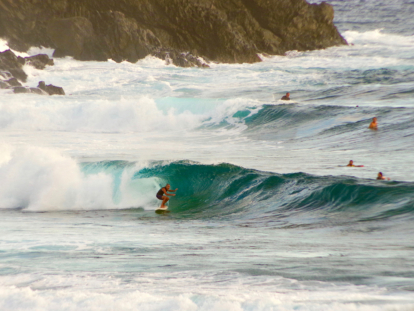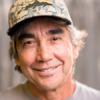Living on Easy
A trip to Amami Ōshima, Japan, transports Gerry Lopez to a familiar feeling on a distant land.
Listen to the story
I was born in Honolulu in the late 1940s, before Hawai‘i was a state. In those early days, the living was easy. It was called “island style,” and that was the way everyone lived … well, at least everyone we knew. The beach across from the zoo was where we spent afternoons after school and on weekends. There were tourists down near the hotels and at the Sunday lū‘au at Queen’s Surf, but otherwise, the rest of Waikīkī Beach and Kapi‘olani Park was mostly locals only. My mom took my brother and me surfing one day at Baby Queen’s, and none of us, Mom included, had any idea that life going forward would inexorably shift to another path. We’d both been bitten by the surf bug that day, but it was Victor who felt it first.
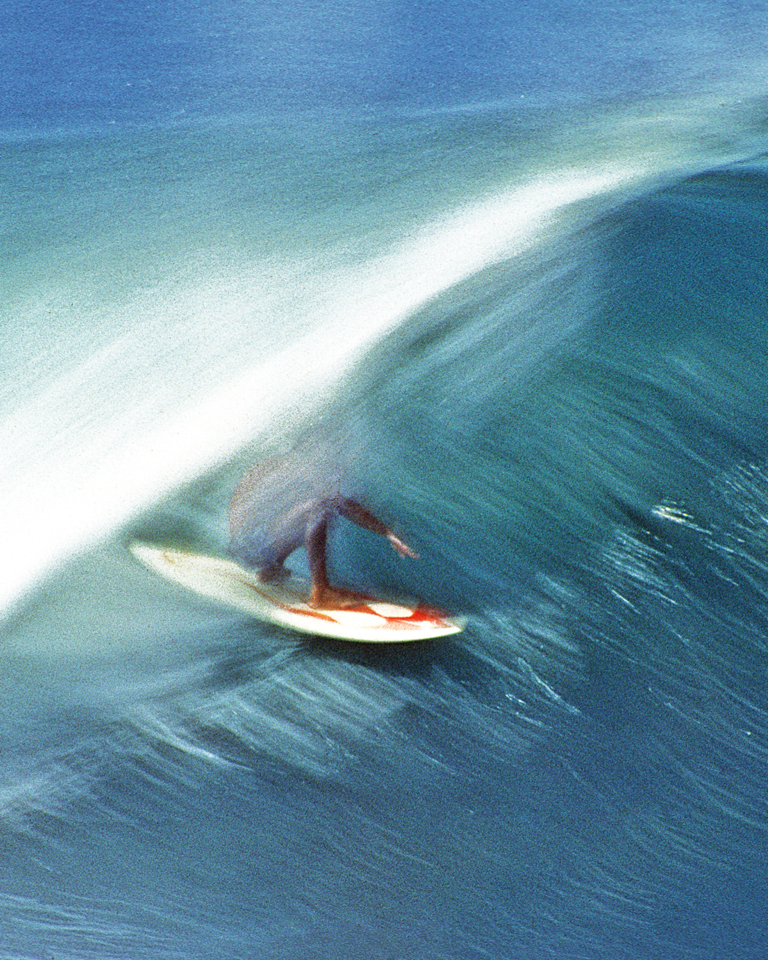
Gerry and Pipeline go together like peanut butter and chocolate—great on their own, but much better together. North Shore, O‘ahu. Photo: Jeff Divine
His school buddy, Stanford Chong, and his whole family surfed together, so before long, Vic had his own surfboard and was surfing with them all the time. They owned a country house on the beach on O‘ahu’s East Side between Crouching Lion and Chinaman’s Hat (Mokoli‘i), and often I’d be invited to spend the weekend there since Stanford’s sister, Marlene, and I were classmates.
They had a large house with a big yard and some sprawling hau trees around an outdoor barbecue and firepit. We would drive out from Honolulu town, over the Pali, through Kāne‘ohe town, along the windward side—the ocean on our right and majestic Ko‘olau Range on the left. The East Side gets rain almost daily, so everything is green and growing. In the morning, we’d walk the beach to find any Japanese glass floats that may have washed ashore, although the grown-ups always got the jump, waking earlier and knowing where to look. After breakfast, sometimes Mr. Chong would take the boat out with all the kids and fish a little or explore Chinaman’s Hat or spearfish the reefs in front of the house.
Somewhere along the line, and without even understanding it was happening, I developed a little boy’s affinity for this side of the island. It was like falling under a spell … there was its special feel, look, smell and idiosyncrasies. Like when the trade winds blew, I learned to be on the lookout for Portuguese man-of-war and so avoid its painful sting. Or noticing how vivid and bright the stars were on dark nights, without the town lights to spoil them.
I had no idea at the time, but later on, when older and looking back, I realized how idyllic that was—life at that young age is full of questions, uncertainty and finding oneself on shaky ground. But those times on the East Side were like putting aloe vera on a burn; there was a very distinct, soothing ahhh about it, and I looked forward to each time we got to go.
In a way, life is a little like Dad’s car … it takes us down the road, and at some point, a stop at the service station is needed to keep going. The weekends at the Chongs’ beach house were that gas-station stop. Then things changed. I began to run on another kind of fuel; surfing started to rear its head and fill my tank. I don’t think I even realized that one had replaced the other, or if replace was even what it did. Surfing, as the complete endeavor, inevitably takes not just some of one’s time—it takes it all. A deep passion develops, and while it’s all one wants to do, at the same time, it stokes a great fire down inside that drives a person to … well, to be insatiable for even more of it.
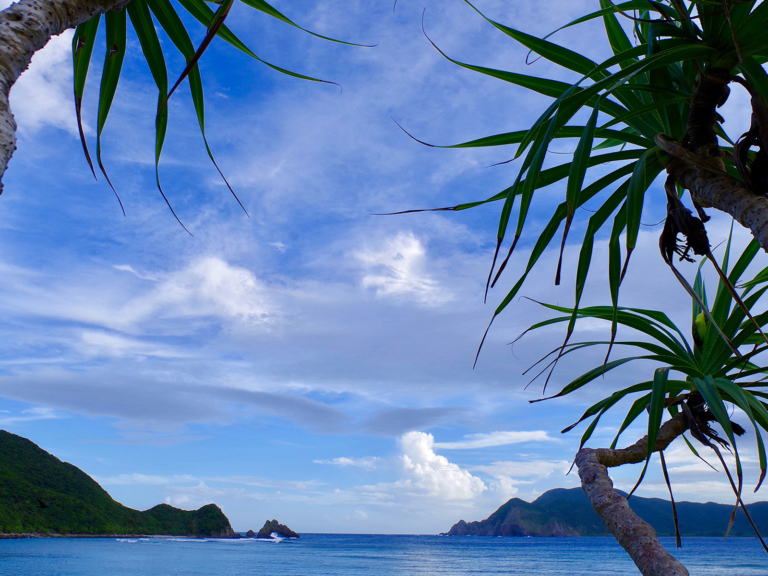
The scenery that made Mr. Pipeline feel right at home, once he got back into his slippers. Amami Ōshima, Japan. Photo: Hideaki Satou
Perhaps that earliest harmony at the Chongs’ had something to do with it, but I found myself living in Kahalu‘u, way out on the East Side, and spending a lot of time in the car driving: either to town for my surf-shop business, Ala Moana for summertime surf or the long haul to the Country in the winter for the waves there. Sometimes if I was a passenger, I would look at the Chong house as we zoomed by. I never saw anyone; a couple of times I stopped, but it was empty and the sweet and tangy awareness that I used to have was no more. But surfing was keeping my gas tank full, so I guess I didn’t miss it.
Life happened and the years flew by. In 2017, the film crew at Patagonia suggested a documentary film project that must have been meant to be because it unfolded like a spinnaker sail does when a stiff wind blows—not that it was without a few wrinkles—but by spring last year we were ready to premiere it.
A tour ensued throughout the US, Europe, Australia and Japan. The director, Stacy Peralta, did most of the stops with me except for Japan. He was busy, so I went alone. In the undertaking of this assignment, we never thought that something like COVID-19 would have such an effect, but it surprised the entire world and certainly put up some hurdles for our movie tour. Japan had only just opened its doors to visitors when I got there. We had showings in Kamakura, Sendai, Tokyo, Osaka and Fukuoka: all cities where I had been before, with old friends in all of them, and the film showings went like clockwork.
The final stop was Amami Ōshima, one of the little islands near Okinawa that I’d heard about but never visited. The monkey wrench was that a typhoon with an unpredictable trajectory was aimed toward the same place we were bound for. For most people, a typhoon warning is usually a good reason to reschedule one’s trip. For a surfer, however, this is a sure sign of surf coming and serves as an attraction rather than a deterrent, and our entire Patagonia Japanese crew were surfers. Of course, we went.
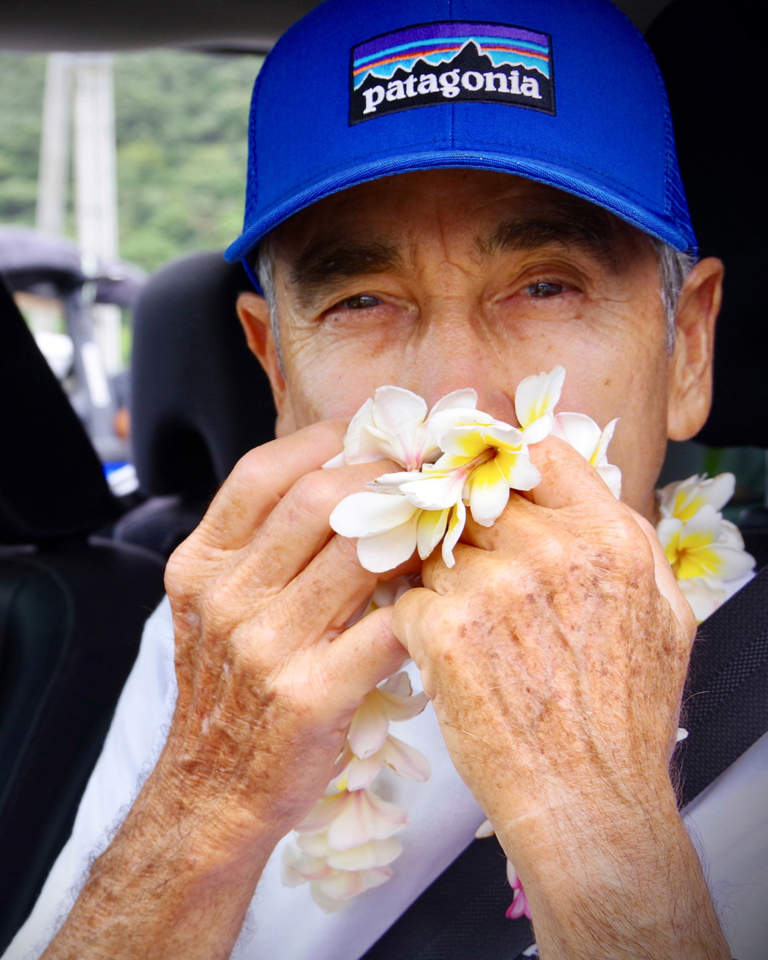
Gerry stops to smell the roses (or plumerias, in the case of Amami Ōshima). Photo: Hideaki Satou
As we flew into the airport, the ocean looked spectacular from above, deep blue with strong trade winds blowing whitecaps and swells toward the islands. Staring out the window, I was mind-surfing those waves on a downwind SUP or a wing foil.
We landed still in our city clothes, long pants, shoes. But all our friends in the terminal were waiting for us in shorts and slippers. Yeah, man, at a glance, I could tell they were all living on easy. I couldn’t wait to change clothes and join them. As soon as I walked out the plane’s door, something happened … a feeling, a smell, the green hills. I don’t know what it was, but I felt like I was back to some place I had been before. I looked more closely. The plants and trees were familiar, the ocean had a windswept look I recognized and waves were breaking in crystal-clear water over coral reefs, sandy beaches; it felt like I should know it even though I didn’t.
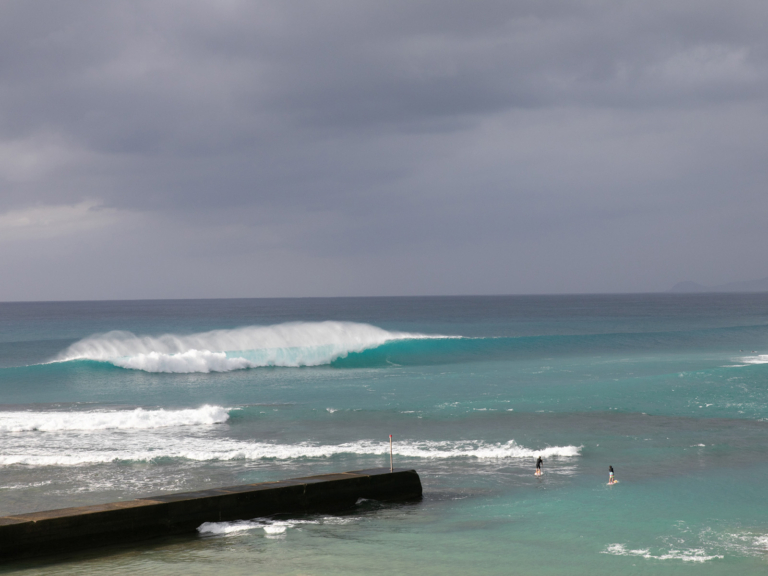
Dreamy tropical lefthanders made Gerry’s surf career, and they never get old. Photo: Hisayuki Tsuchiya
We were greeted with leis by some old friends and many new ones who had an easy, friendly, familial excitement. Driving in the car back to our host’s home and surf shop was eerily déjà vu, too. When we stopped, I quickly changed into my shorts and slippers and just that made me feel more at home in these surroundings.
A quick walk down to the beach to connect with the sand and the water, touching them and seeing the weathered siding on the homes that comes from living on a windward shore, gave me an astonishing revelation for the strong sensations I was having. I was back at the Chongs’ house on the East Side from 65 years ago—that loving feeling had never left. It just needed the right coaxing to come rushing back like it always had before. Good feelings are strange and powerful. We usually take them for granted as we revel in them, never thinking how deep they go or how long they’ll last. The rest of our trip was totally smooth and seamless, as one would expect with family and friends. We drove to the other side of the island. For me, the whole way looked and felt like Hawai‘i. We surfed excellent waves with dear friends, ate great food, talked story—life was very good.
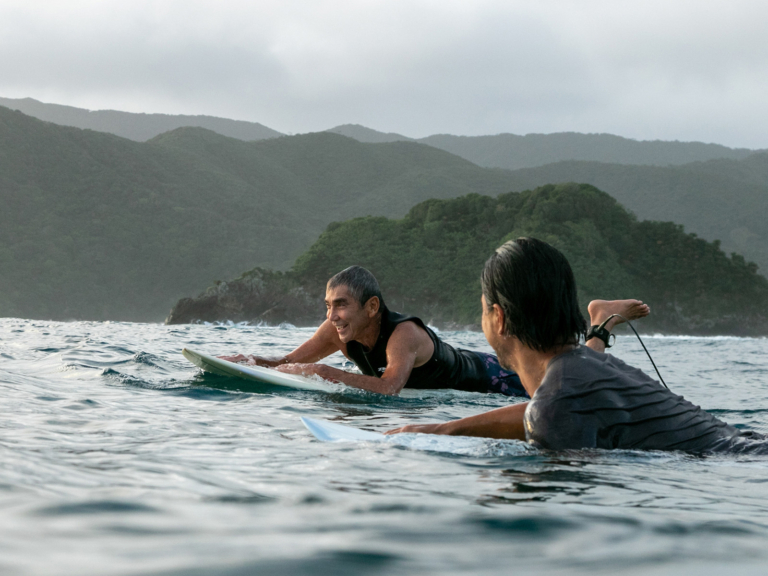
Gerry and Patagonia Surf ambassador Hayato Maki from Okinawa, Japan, paddle back out for one more “one more.” But even that won’t be their last. Photo: Hisayuki Tsuchiya
The next day we showed the film to the local surf community. They were an awesome audience. That evening, with the hurricane hovering just over the horizon, we flew out, arriving late into Tokyo. The typhoon hit Okinawa, but maybe all the good vibes were strong enough to cause the storm to veer away from Amami Ōshima.
It was a wonderful trip, “island style” the entire way and one I won’t soon forget. I left the little island and its tight surf community with an absolutely full tank of premium-grade fuel. I’ll just bet that everyone else was topped off, too.
